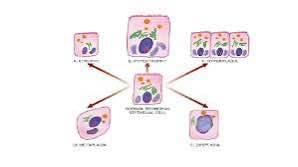مدرس المادة
CELLULAR ADAPTATION
Overview: The four basic types of cellular adaptation to be discussed in this section are hyperplasia, hypertrophy, atrophy, and metaplasia.
HYPERPLASIA
Basic description: Increase in the number of cells.
- Hyperplasia is characterized by an increase in cell number because of proliferation of differentiated cells
- Hyperplasia is an adaptive response in cells capable of replication,
- Hyperplasia takes place if the tissue contains cell populations capable of replication; it may occur concurrently with hypertrophy and often in response to the same stimuli.
- Hyperplasia can be physiologic or pathologic. In both situations, cellular proliferation is stimulated by growth factors that are produced by a variety of cell type.
- The two types of physiologic hyperplasia are
(1) Hormonal hyperplasia, exemplified by the proliferation of the glandular epithelium of the female breast at puberty and during pregnancy
(2) Compensatory hyperplasia, in which residual tissue grows after removal or loss of part of an organ. For example, when part of a liver is resected.
- Most forms of pathologic hyperplasia are caused by excessive hormonal or growth factor stimulation. For example after a normal menstrual period there is a burst of uterine epithelial proliferation that is normally tightly regulated by stimulation through pituitary hormones and ovarian estrogen and by inhibition through progesterone. However, a disturbed balance between estrogen and progesterone causes endometrial hyperplasia, which is a common cause of abnormal menstrual bleeding.
- Hyperplasia also is an important response of connective tissue cells in wound healing, in which proliferating fibroblasts and blood vessels aid in repair. In this process, growth factors are produced by white blood cells (leukocytes) responding to the injury and by cells in the extracellular matrix.

تحميل الملف
